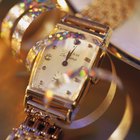
Comstock Images/Comstock/Getty Images
Gold cufflinks add a touch of elegance to a suit or tuxedo but fake gold jewelry can fade and even stain your skin or clothing. If you've received a pair of gold-looking cufflinks as a gift or want to verify that you have genuine gold accessories, you can check for certain gold stamps. Federal law mandates that real gold products have special markings to identify the karat weight, gold content or gold overlay. However, if you own antique cufflinks, like a pair from a Civil War officer's uniform, these markings will be absent. In some cases, you may need to consult a jeweler.
Examine the cufflinks in a well-lit area or if possible, take them outside to look at them under natural light.
Flip the cuffs over to look at the backs. Cufflinks have a large post. If your cufflinks do not have posts, they may be buttons or button covers.
Use the magnifying glass to look for gold markings. Look for the numbers 10, 12, 14, 18, 22 or 24 followed by the letter K. You can find this gold karat marking at the back of the cufflinks where it cannot be seen when worn.
Search for other letter markings like GF, GO or RGP. These abbreviations stand for gold-filled, gold overlay or rolled gold plate, respectively.
Turn the cufflink over in your hand and look at the edges. If the gold appears worn away or tarnished looking, this may indicate that your cufflinks are not authentic. Poor workmanship could mean fake gold.
Related Articles

How to Clean Gold Jewelry With Stones

How to Identify a Counterfeit Gucci ...

How to Tell If a Silver Chain Is Real

How to Spot a Replica Baume Watch

How to Get Rust off a Fake Gold Necklace

How to Tell a Real Tiffany's Necklace ...

How to Get Kinks Out of Gold Chains

How to Tell If Ray Ban Sunglasses Are ...

How to Change the Battery in a Cartier ...

How to Check for an Original G-Shock

How to Spot a Fake Mont Blanc Watch

How to Authenticate Gucci Belts

How to Take Out Scratches From Silver ...

How to Clean Gold Plated Watches

How to Spot Counterfeit Tommy Hilfiger

How to Identify a Fake Perpetual Oyster ...

How to Spot a Replica Invicta Watch

How to Clean Fake Silver

How to Spot Fake Citizen Watches

How to Tell If Your G-Shock Is Fake?
References
Writer Bio
Mimi Bullock's writing reflects her love of traveling the back roads of small towns and sampling the local cuisine. As a regular feature writer for "Southern Hospitality Traveler" and journalist for "Beachin' Magazine," she gets to experience the rich heritage of the southern culture. She is also a licensed cosmetologist who has her own skin care line.
Photo Credits
Comstock Images/Comstock/Getty Images